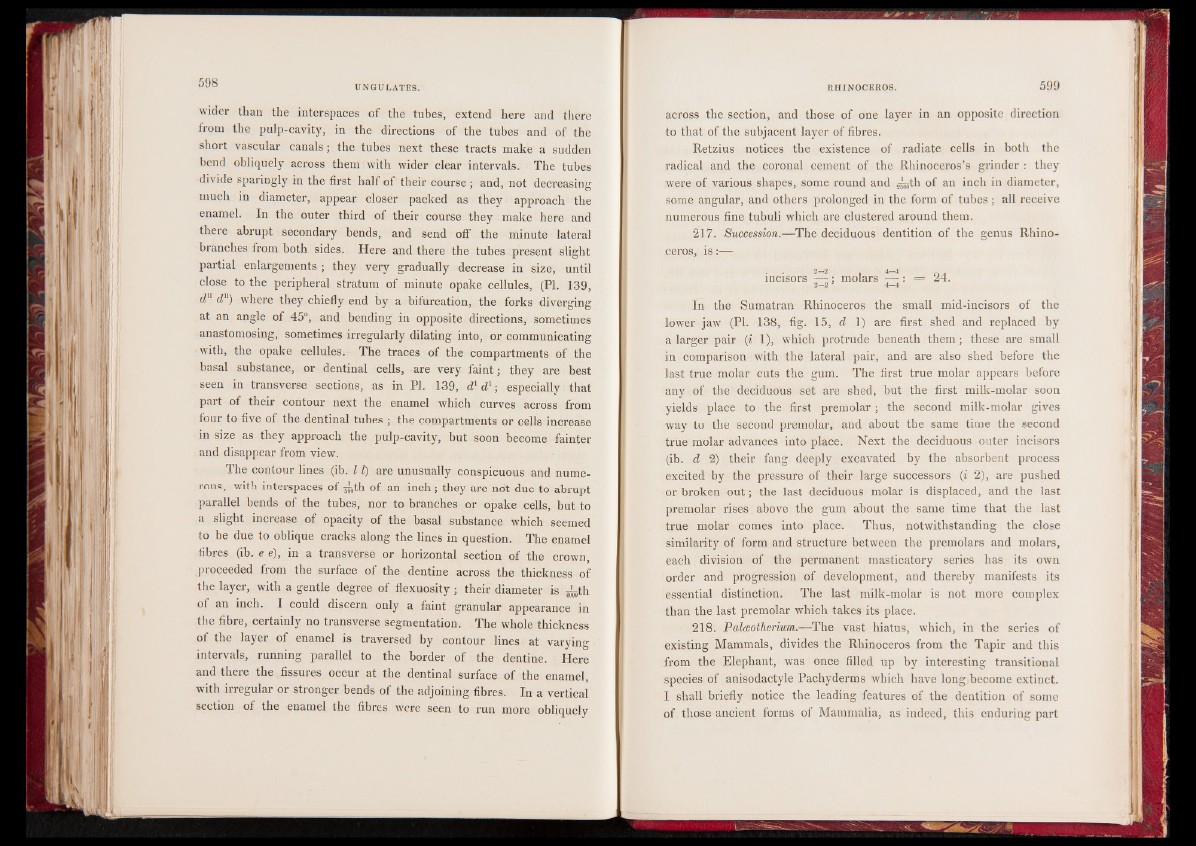
wider than the interspaces of the tubes, extend here and there
from the pulp-cavity, in the directions of the tubes and of the
short vascular canals; the tubes next these tracts make a sudden
bend obliquely across them with wider clear intervals. The tubes
divide sparingly in the first half of their course ; and, not decreasing
much in diameter, appear closer packed as they approach the
enamel. In the outer third of their course they make here and
there abrupt secondary bends, and send off the minute lateral
branches from both sides. Here and there the tubes present slight
partial enlargements ; they very gradually decrease in size, until
close to the peripheral stratum of minute opake cellules, (PI. 139,
dlx du) where they chiefly end by a bifurcation, the forks diverging
at an angle of 45°, and bending in opposite directions, sometimes
anastomosing, sometimes irregularly dilating into, or communicating
with, the opake cellules. The traces of the compartments of the
basal substance, or dentinal cells, are very faint; they are best
seen in transverse sections, as in PI. 139, dl dl; especially that
part of their contour next the enamel which curves across from
four to five of the dentinal tubes ; the compartments or cells increase
in size as they approach the pulp-cavity, but soon become fainter
and disappear from view.
The contour lines (ib. 11) are unusually conspicuous and numerous,
with interspaces of ^th of an inch; they are not due to abrupt
parallel bends of the tubes, nor to branches or opake cells, but to
a slight increase of opacity of the basal substance which seemed
to be due to oblique cracks along the lines in question. The enamel
fibres (ib. e e), in a transverse or horizontal section of the crown,
proceeded from the surface of the dentine across the thickness of
the layer, with a gentle degree of flexuosity; their diameter is j^th
of an inch. I could discern only a faint granular appearance in
the fibre, certainly no transverse segmentation. The whole thickness
of the layer of enamel is traversed by contour lines at varying
intervals, running parallel to the border of the dentine. Here
and there the fissures occur at the dentinal surface of the enamel,
with irregular or stronger bends of the adjoining fibres. In a vertical
section of the enamel the fibres were seen to run more obliquely
across the section, and those of one layer in an opposite direction
to that of the subjacent layer of fibres.
Retzius notices the existence of radiate cells in both the
radical and the coronal cement of the Rhinoceros’s grinder : they
were of various shapes, some round and 2-^jth of an inch in diameter,
some angular, and others prolonged in the form of tubes; all receive
numerous fine tubuli which are clustered around them.
217. Succession.—The deciduous dentition of the genus Rhinoceros,
is:—
i• nci• sors 2—2 mo,l ars 4——4 : = n^ 4. . 2—2 9 4—4
In the Sumatran Rhinoceros the small mid-incisors of the
lower jaw (PI. 138, fig. 15, d 1) are first shed and replaced by
a larger pair (i 1), which protrude beneath them; these are small
in comparison with the lateral pair, and are also shed before the
last true molar cuts the gum. The first true molar appears before
any of the deciduous set are shed, but the first milk-molar soon
yields place to the first premolar; the second milk-molar gives
way to the second premolar, and about the same time the second
true molar advances into place. Next the deciduous outer incisors
(ib. d 2) their fang deeply excavated by the absorbent process
excited by the pressure of their large successors (i 2), are pushed
or broken out; the last deciduous molar is displaced, and the last
premolar rises above the gum about the same, time that the last
true molar comes into place. Thus, notwithstanding the close
similarity of form and structure between the premolars and molars,
each division of the permanent masticatory series has its own
order and progression of development, and thereby manifests its
essential distinction. The last milk-molar is not more complex
than the last premolar which takes its place.
218. Palceotherium.—The vast hiatus, which, in the series of
existing Mammals, divides the Rhinoceros from the Tapir and this
from the Elephant, was once filled up by interesting transitional
species of anisodactyle Pachyderms which have long become extinct.
I shall briefly notice the leading features of the dentition of some
of those ancient forms of Mammalia, as indeed, this enduring part